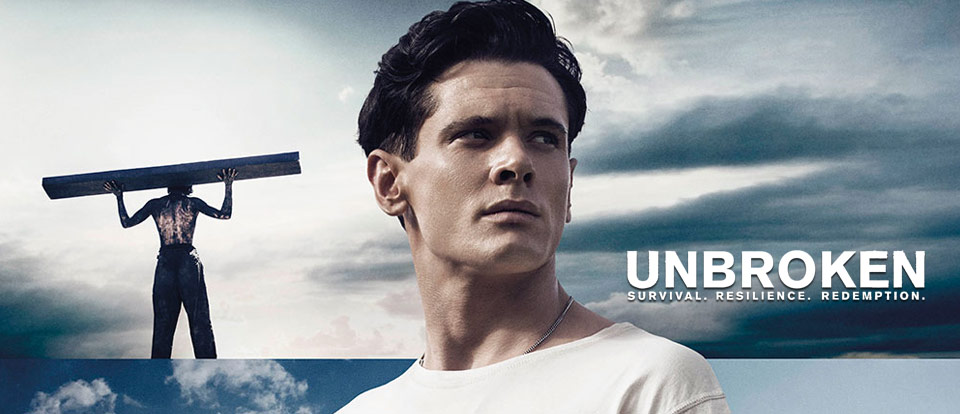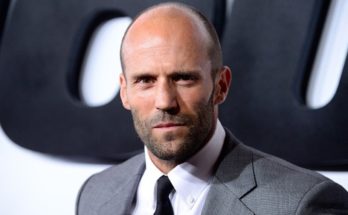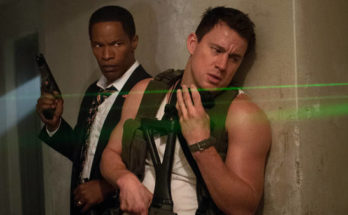How do you film the great story of a man who lived “unbroken” – from one thousand nine hundred seventeen until his death in two thousand fourteen – ninety – seven years of robust living coupled with endurance? The film I viewed tried to do this well – – hoping to give us Louie Zamperini’s unquenchable spirit to live.
We first see Louie in Torrance, California – hell-bent on kid-mischief – stealing… smoking and drinking booze… outfoxing the police… The thing that’s clear is how fast he runs when he’s trying to save his skin from capture. As a young boy he’s ably played by J.C. Valleroy. Louie’s older brother, Pete, played in his younger years by John D’Leo, turns his brother’s energy towards distance running. Soon Louie has become the fastest youth in all of the U.S. By the time he’s nineteen years old he’s qualified for the Thirty-Six Olympics – where he’s summoned to meet Hitler… That last part of his mile run established a time that made Louie famous world – wide.
By now the Second World War was coming of age; and Louie signed up and became a bombardier. Here is the start of the essential part of the film that shows his unbroken strength of character. By this time the role of Louie Zamperini has passed to Jack O’Donnell; and truth to tell he does a great job recreating Louie on screen. The challenges that the real Louie faced from the time when his plane crashed far out in The Pacific – being stranded with two for forty-seven days – living off shark and random bird – being baked by the sun and strafed by a Jap plane – being tossed doll – like on the sea – then captured and tortured in Japanese prisons – then wantonly freed at War’s end – – and abruptly shipped home in nineteen forty – five. (Twenty – eight years old was his age.) For someone who has read the book – UNBROKEN – there is yet the added lifetime wherein Louie begins to conquer or quell the demons that the War created. The falseness of the title, UNBROKEN, is that really the World War broke him; and it was only when he got home, married, had a family, beat alcohol, and got rid of the dreams of the maniacal “Bird” menace – by spiritually forgiving him through his reborn Christian faith – that you could say he’s “unbroken”.
Louie spent much of his later years talking to audiences about the gift of forgiveness. He healed himself by helping folks heal whatever wounds they’d suffered. This was truly the kept promise he’d gasped as he lay huddled in a bobbing raft as it was tossed on the ocean late one night.
What we see as the film concludes – – before the windup script which tells us of his life after the war – is a man that really has been broken. Yes, he could walk and talk and outwardly looked pretty good. But no man could endure what he had to endure without breaking – inside of him. It took the rest of his life to get past the War..
So Hildebrand’s massive story of Louie, which covers all of his life – or at least up to the few years before his demise – is truly an UNBROKEN story. But you couldn’t call the part that Angelina Jolie – the director – and the four screen writers – two Coen brothers plus William Nicholson and Richard La Gravenese – did as showing him unbroken. No one saw in Louie what happened inside him. All we saw were the torture – scenes.
Nevertheless what came out of their efforts is a marvelous life tribute to Louie Zamperini. We should be proud of the man and the land that produced him. He gave up plenty to be part of that wartime. I’m sure he could have stayed closer to home in some effort connected with his sport. Seeing what he went through – I think – – is an experience that is realistic enough to grant empowerment.
There is one scene that is embedded in my mind: The prison head – a sadistic monster nicknamed “The Bird” – who tortured Louie with anything that he found on hand – spied a pile of timber – laying near where they stood and told Louie to pick up one and hold it above him – and then turning to a guard, said: “If he drops it, shoot him!” Louie could barely lift it to his shoulder, but finally he got it up there, steadied his legs as the weight forced him off balance, and continued to keep it there… Soon as minutes passed, the bulk of the prisoners start to watch him – standing in awe. I thought to myself, ‘They are all praying, hoping that he has the strength to keep on.’ The connection between the men and Louie – with silence reigning – was quite moving. And then – – a miracle – as if from their strength prayed – Louie hoisted that timber high above his head and growled profusely at “The Bird”. It was all too much for even the evil “The Bird” showed. He started weeping and came over to Louie and knocked him down and beat him with the weakness he had left. But it didn’t give him relief. The final scene shows this poor excuse of a man grieving at his own helplessness.
It took years for Louie to rid himself of the nightly specter of “The Bird” – as he stood before Louie – one nightmare coming each night. Only his forgiveness made the nightmares go away. (Unfortunately this part of Louie’s life isn’t filmed.)



